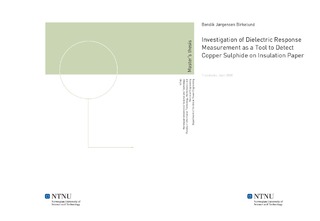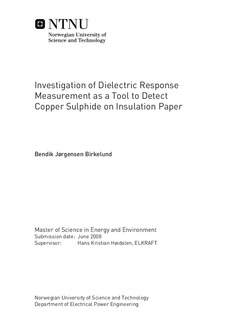| dc.description.abstract | Several power transformers has, during the last two decades, broken down due to the copper sulphideproblem. Corrosive sulphur reacts with the copper conductor contaminating the surroundinginsulating paper. To this day there are no reliable nondestructive methods to detect copper sulphidecontamination in a power transformer.Dielectric frequency measurement is a nondestructive tool used in the transformer industry. Themeasurements can give important information about the condition of the transformer insulation. Inthis master thesis the usage of dielectric frequency measurement as a tool to detect copper sulphideon insulation paper has been investigated.The task has been divided into two subtasks: Subtask I: Develop and test different methods to create and classify copper sulphide contamination on paper samples. Subtask II: Examine the dielectric frequency response of the contaminated samples as a function of copper sulphideSolution and results for Subtask IFor sample creation two methods were used: Creating samples out of paper strips taken from existing transformers Growing copper sulphide on paper in the laboratory for three, ffve, eleven and fourteen daysFor copper sulphide classiffcation three methods were used: Resistance measurement Area percentage calculation Classiffcation by the number of days grown.For sample creation the growth of copper sulphide samples seemed to be the better choice as the gapsbetween the samples of strips gave large uncertainties in the dielectric frequency response. The growthvaried in some extent and days of growth some times became insuffcient in classifying degree of coppersulphide. Good connection between the copper and paper may be an important factor, and the sizeof the samples is recommended to be kept small. For all samples, contamination got heaviest at theedge. For the samples grown for fourteen days the paper became too fragile for dielectric frequencytesting.The resistance measurement classiffcation method seemed to be the best choice, as it could copewith large variations in the contamination. The area percentage calculation method worked undervery limiting conditions as the contamination had to be of a certain brightness level and with lowvariations in colour. The classiffcation due to days of growth came too short as the contaminationbetween ffve and seven days were not that signiffcant. Larger time intervals can be a solution.Solutions and Results from Subtask IIDielectric frequency measurements were tested with two separate equipments: The Insulation Diagnostic Analyser: Frequency range: 1mHz-1kHz .The Alpha-Analyser: Frequency range: 100Hz-1MHzAll tests where performed in equilibrium with air humidity at the time of testing.The gaps between the strips, used in the samples, gave a substantial effect to the dielectric frequencyresponse. This effect was clearest at the lower frequencies, but some effect can also be seen inthe higher region. At the lower frequencies the results gave no indication of any effect in the dielectricresponse due to copper sulphide. However, the gap effect may have concealed the effect, and testingwithout gaps is recommended.At the higher frequencies the grown copper sulphide samples gave some variations in the dielectricfrequency response. The variations in results also occurred between samples with the same creationconditions. This may still indicate a relation between copper sulphide and dielectric response at higherfrequencies. Even with the large deviations there were, at frequencies above 100kHz, a steeper increasein losses for the contaminated samples. Of the grown samples created only samples of ffve and sevendays growth were tested. This gives a limited research foundation and further investigation is needed.Conclusions and Future WorkIn general there might be a correlation between copper sulphide and dielectric frequency measurement.Growing samples has turned out to work well as the test object provider. By combining days of growthwith resistance measurements the classiffcation of the contamination should be suffcient. However,more research is absolutely needed and some suggestions for further work are as follows: Dry the samples to minimise the water effect on the dielectric frequency measurement. Creating a new smaller sample cell for the Insulation Diagnostic Analyser, so the sample size can be reduced and sample without gaps can be run in the lower frequency range. Increase the time gap between the samples grown to get larger differences in contamination, and reduce the effect of variations. Reducing the temperature may be a way to increase days of growth. However, in this case more research on the temperature dependencies of copper sulphide growth is needed. | nb_NO |

